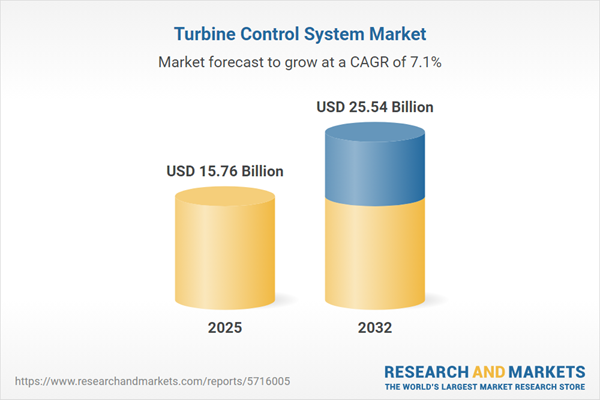Speak directly to the analyst to clarify any post sales queries you may have.
The turbine control system market is evolving quickly as senior leaders prioritize digital transformation and investment in automation to enhance reliability and future-readiness. Strategic adoption of advanced control platforms, adaptable to emerging regulatory and performance demands, is now central to maintaining operational agility.
Market Snapshot: Turbine Control System Market Size and Growth
The global turbine control system market is experiencing sustained momentum, valued at USD 14.71 billion in 2024 and set to expand to USD 15.76 billion in 2025. By 2032, this sector is expected to reach USD 25.54 billion, reflecting a CAGR of 7.13%. Growth is driven by swift adoption of integrated automation technologies that enable seamless compatibility with both modern and legacy plant environments. As organizations align digital initiatives with operational and compliance goals, investments in adaptive control solutions continue to boost reliability and system lifecycle performance across the energy and manufacturing space.
Scope & Segmentation of the Turbine Control System Market
- Product Types: Hardware includes actuators, distributed control systems (DCS), programmable automation controllers (PAC), programmable logic controllers (PLC), sensors, and communication modules. Service portfolios feature consulting, installation, upgrades, and maintenance. Software encompasses human machine interfaces (HMI), analytics, and supervisory control and data acquisition (SCADA) solutions for both on-premise and cloud environments.
- Turbine Types: Systems are tailored for gas, steam, and wind turbines, with dedicated integration and lifecycle strategies to meet sector-specific reliability standards in established and emerging markets.
- Control Types: Digital architectures span DCS, energy management systems (EMS), PLC, and advanced SCADA platforms, supporting scalable automation and real-time monitoring in diverse operating conditions.
- Applications: Core use cases include chemical processing, oil and gas, conventional power generation, and renewable initiatives such as geothermal, wind, and solar thermal, serving both legacy and new infrastructure demands.
- End Users: The market addresses independent power producers, utilities, industrial manufacturers, and oil and gas operators, each selecting technology to align with distinctive compliance and operational strategies.
- Regions Covered: Market dynamics reflect regulatory and technological variations across the Americas, Europe, Middle East and Africa, and Asia-Pacific, with adoption patterns shaped by digital maturity and policy frameworks.
- Leading Companies Analyzed: The report examines strategies and performance of General Electric Company, Siemens Aktiengesellschaft, Mitsubishi Heavy Industries Ltd., ABB Ltd, Schneider Electric SE, Emerson Electric Co., Honeywell International Inc., Rockwell Automation Inc., Woodward Inc., and Yokogawa Electric Corporation.
Key Takeaways for Senior Decision-Makers
- Digital technology integration and real-time analytics improve asset visibility, accelerate operational responses, and drive more informed maintenance strategies, directly enhancing system performance.
- Edge computing and robust connectivity architectures support dependable plant operation, reducing the risk of unplanned outages and tightening security across critical infrastructure environments.
- Investment in local sourcing and diversified supply chains provides organizations with increased flexibility and assists regulatory compliance initiatives, supporting agile responses to shifting trade and procurement dynamics.
- Modular and custom control solutions are increasingly adopted, particularly in renewables and modern manufacturing, to meet unique operational demands while enabling phased business transformation.
- The prevalence of value-added upgrades and managed services allows organizations to extend asset life, realize efficient modernization, and avoid wholesale replacements.
- Effective partnerships across vendors, consultants, and end users accelerate adoption of interoperable and scalable control architectures, aligning with broader sector digitization trends.
Tariff Impact on Global Turbine Control System Market
The introduction of new US tariffs in 2025 is prompting a shift in global supply chain strategies, with increased focus on regional sourcing and domestic manufacturing. Suppliers are adapting by providing modular, cost-efficient control solutions and incorporating greater flexibility into procurement contracts. These actions are designed to help organizations maintain resilience and responsiveness as international trade policies evolve.
Methodology & Data Sources
Market insights are developed through collaboration with sector specialists, feedback from senior plant engineers, and executive roundtables. The research approach incorporates technical literature, regulatory filings, financial reports, and patent analyses, ensuring all findings are validated through peer review and data triangulation.
Why This Report Matters for Senior Decision-Makers
- Delivers actionable insights for developing and implementing turbine control strategies aligned with evolving regulatory and technological landscapes.
- Equips leaders to manage digital risk, advance technology adoption, and identify opportunities in high-growth and established regions.
- Supports accelerated modernization and improved operational alignment across business units, while ensuring ongoing compliance and stronger performance outcomes.
Conclusion
This report enables senior decision-makers to guide their organizations through dynamic changes in turbine control technologies, ensuring effective modernization and safeguarding operational competitiveness for the future.
Additional Product Information:
- Purchase of this report includes 1 year online access with quarterly updates.
- This report can be updated on request. Please contact our Customer Experience team using the Ask a Question widget on our website.
Table of Contents
3. Executive Summary
4. Market Overview
7. Cumulative Impact of Artificial Intelligence 2025
List of Figures
Samples

LOADING...
Companies Mentioned
The key companies profiled in this Turbine Control System market report include:- General Electric Company
- Siemens Aktiengesellschaft
- Mitsubishi Heavy Industries, Ltd.
- ABB Ltd
- Schneider Electric SE
- Emerson Electric Co.
- Honeywell International Inc.
- Rockwell Automation, Inc.
- Woodward, Inc.
- Yokogawa Electric Corporation
Table Information
| Report Attribute | Details |
|---|---|
| No. of Pages | 183 |
| Published | October 2025 |
| Forecast Period | 2025 - 2032 |
| Estimated Market Value ( USD | $ 15.76 Billion |
| Forecasted Market Value ( USD | $ 25.54 Billion |
| Compound Annual Growth Rate | 7.1% |
| Regions Covered | Global |
| No. of Companies Mentioned | 11 |









